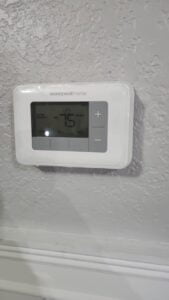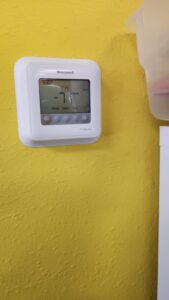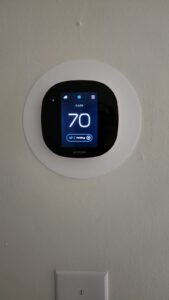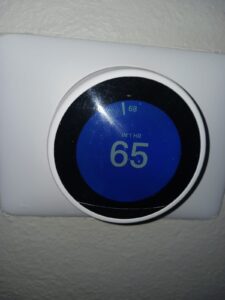6 Best Thermostat Settings to Fight Dust Mites and Mold
In the quest for a comfortable and healthy home, understanding the relationship between your thermostat settings and the prevalence of dust mites and mold is crucial. This comprehensive guide delves into how proper temperature control can significantly reduce these common household allergens, ensuring a safer and more pleasant living environment.
Understanding Dust Mites and Mold in HVAC Systems
HVAC (Heating, Ventilation, and Air Conditioning) systems are central to maintaining comfort in homes and buildings. However, they can also become breeding grounds for dust mites and mold if not properly maintained. Understanding how these allergens thrive in HVAC systems and the steps to mitigate them is crucial for a healthy indoor environment.
Dust Mites in HVAC Systems
Dust mites are tiny pests that thrive in warm, humid environments. They feed on organic matter, such as skin flakes shed by humans, and are commonly found in household dust.
- Breeding Grounds: While dust mites don’t live inside HVAC systems, they can thrive in the dust that accumulates in ductwork, filters, and other components.
- Distribution: When the HVAC system is active, it can distribute dust mite allergens throughout a home or building, exacerbating allergies and respiratory issues.
Mold in HVAC Systems
Mold is a type of fungus that grows in moist environments. HVAC systems can provide an ideal habitat for mold if moisture is present.
- Growth Areas: Mold can grow on cooling coils, humidifiers, condensate pans, and in ductwork. This is especially true if there is stagnant water or if the system is not properly drained.
- Spore Distribution: Like dust mites, mold spores can be distributed throughout a building via the HVAC system, leading to indoor air quality issues and health problems for occupants.

The Health Impacts of Dust Mites and Mold: A Critical Overview
Dust mites and mold are common household allergens that can have significant health impacts, especially for individuals with allergies, asthma, or compromised immune systems. Understanding these impacts is crucial for maintaining a healthy living environment.
Dust Mites: Tiny Pests, Big Problems
Dust mites are microscopic creatures that thrive in warm, humid environments. They are commonly found in bedding, carpets, and upholstered furniture. These mites feed on dead skin cells and flourish in environments where human dander is present.
- Allergic Reactions: Many people are allergic to dust mite droppings and body fragments. Exposure can lead to symptoms such as sneezing, runny or itchy nose, and itchy eyes.
- Asthma Triggers: For asthmatics, dust mites can trigger asthma attacks. Symptoms may include difficulty breathing, chest tightness, and wheezing.
- Eczema Flare-Ups: Individuals with eczema may experience worsened symptoms when exposed to dust mites.
Mold is a type of fungus that grows in damp, humid conditions. It reproduces through spores that can become airborne and inhaled.
- Respiratory Issues: Mold exposure can cause respiratory problems, including coughing, wheezing, and in severe cases, infections in the lungs.
- Allergic Reactions: Similar to dust mites, mold can cause allergic reactions. Symptoms include sneezing, runny or stuffy nose, itchy throat, and watery eyes.
- Asthma Exacerbation: For people with asthma, mold can trigger attacks, leading to severe respiratory distress.
- Long-Term Health Effects: Prolonged mold exposure can lead to more serious health issues, especially in people with weakened immune systems.
Preventive Measures
- Control Humidity: Keep indoor humidity levels below 50% to inhibit the growth of dust mites and mold.
- Regular Cleaning: Vacuum and dust regularly to reduce dust mites. Use a vacuum with a HEPA filter for best results.
- Mold-Resistant Products: In areas prone to moisture, use mold-resistant products like paints and building materials.
- Ventilation: Ensure good ventilation, especially in areas like bathrooms and kitchens, to reduce moisture.
- Fix Leaks: Repair any leaks promptly to prevent mold growth.
- Air Purification: Consider using air purifiers with HEPA filters to reduce airborne allergens.
Ideal Thermostat Settings to Mitigate Dust Mites and Mold
Creating a comfortable and healthy home environment involves more than just adjusting the temperature. The settings on your thermostat can play a crucial role in controlling humidity levels, which in turn affects the prevalence of dust mites and mold. Here’s a guide to setting your thermostat to help mitigate these common allergens.
Understanding the Role of Temperature and Humidity
- Dust Mites: These thrive in warm, humid environments. They are less active and cannot reproduce as effectively when the humidity is below 50%.
- Mold: Mold grows in moist conditions. Reducing indoor humidity is key to preventing mold growth.
Ideal Thermostat Settings
- Summer Settings: During the summer, set your thermostat to around 78°F (25.5°C) when you’re at home and slightly higher when you’re away. This temperature is comfortable for most people and not warm enough to encourage dust mite proliferation or mold growth.
- Winter Settings: In the winter, aim for a temperature of about 68°F (20°C) when you’re at home. Lowering the temperature further when you’re asleep or away can also save energy and prevent excess humidity.
- Humidity Control: If your thermostat has a built-in humidity control or if it’s connected to a humidistat, set it to maintain indoor humidity levels below 50%. This level is low enough to inhibit dust mites and mold without causing discomfort or overly dry air.
Additional Tips for Humidity and Allergen Control
- Use a Dehumidifier: In areas with naturally high humidity, using a dehumidifier can help maintain the ideal humidity level.
- Ventilation: Ensure proper ventilation in high-moisture areas like bathrooms and kitchens. Use exhaust fans to remove excess moisture.
- Air Circulation: Regular use of ceiling fans or other air circulation methods can help keep humidity levels in check.
- Regular HVAC Maintenance: Ensure your HVAC system, including filters and ducts, is regularly maintained to prevent mold growth and dust accumulation.
- Smart Thermostats: Consider installing a smart thermostat. These devices can automatically adjust the temperature and humidity levels based on your daily routine, weather conditions, and other factors.

Additional Strategies to Combat Dust Mites and Mold
While thermostat settings are crucial, they’re part of a broader strategy.
- Regular Cleaning: Vacuuming and dusting your home regularly, especially in areas prone to dust mites, is essential. Use a vacuum cleaner with a HEPA filter for best results.
- Air Purification: Consider using air purifiers with HEPA filters to capture dust mites and mold spores.
- Dehumidifiers: In areas of your home where humidity levels are hard to control, like basements, use dehumidifiers.
- Duct Cleaning and Maintenance: Regularly cleaning your HVAC system’s ductwork can prevent the spread of dust mites and mold spores throughout your home.
- Use of Anti-Allergen Bedding: Encase mattresses and pillows in covers designed to keep out dust mites.
- Control Mold Growth: Fix leaks and address any water damage promptly. Ensure bathrooms, kitchens, and other moist areas are well-ventilated.
Thermostat Setting for Dust Mites
Dust mites thrive in warm, humid environments. To combat this, the thermostat setting plays a pivotal role. By setting your thermostat lower, you create a less hospitable environment for these pests. An ideal thermostat setting for minimizing dust mites is around 68°F to 72°F (20°C to 22°C). This thermostat setting is not only comfortable for most people but also less conducive to dust mite proliferation.
Thermostat Setting for Mold Prevention
Mold growth is another concern that can be addressed through the right thermostat setting. Mold prefers moist environments, and your thermostat setting can help control indoor humidity. A thermostat setting that maintains a cooler temperature can help reduce indoor humidity levels, thus inhibiting mold growth. Keeping your thermostat setting around 68°F (20°C) is often recommended.
Balancing Thermostat Setting for Comfort and Health
Finding the right balance in your thermostat setting is key. While a lower thermostat setting is effective for controlling dust mites and mold, it’s important to maintain a comfortable living environment. A thermostat setting that is too low can be uncomfortable in colder months, so it’s essential to find a thermostat setting that strikes a balance between comfort and health.
Seasonal Adjustments in Thermostat Setting
Adjusting your thermostat setting seasonally is also important. In the summer, a slightly higher thermostat setting can help keep humidity at bay, while in the winter, a lower thermostat setting aids in reducing dust mites and mold. Regularly adjusting your thermostat setting as the seasons change is a proactive approach to maintaining a healthy indoor environment.
Thermostat Setting and Humidity Control
In addition to temperature, some thermostats also allow you to control humidity levels. This feature can further enhance your ability to use your thermostat setting to combat dust mites and mold. By setting your thermostat to maintain a certain humidity level, you can make your home even less inviting to these allergens.
Advanced Solutions: The AC Therapist’s Approach
At The AC Therapist, we specialize in creating optimal indoor environments, particularly focusing on the crucial role of thermostat settings in combating dust mites and mold. Our approach combines state-of-the-art technology with expert knowledge to ensure your home or business in the Tampa Bay area maintains the best possible air quality. Here’s how we tackle these common issues:
- Precision Thermostat Settings: We understand that the right thermostat setting is key to controlling indoor humidity levels, which directly impacts the proliferation of dust mites and mold. Our team advises on the ideal thermostat settings for your specific environment, typically recommending settings that maintain a balance between comfort and low humidity levels.
- Smart Thermostat Installation: Leveraging the latest in HVAC technology, we install smart thermostats that offer advanced control over your indoor climate. These devices can be programmed to automatically adjust the temperature and humidity levels, ensuring your space remains below the threshold that encourages dust mite and mold growth.
- Customized Climate Control Strategies: Recognizing that every space is unique, we provide customized climate control solutions. This includes assessing your specific needs and recommending thermostat settings based on factors like local climate, home insulation, and personal comfort preferences.
- Humidity Monitoring and Control: Alongside thermostat settings, we focus on comprehensive humidity control. This may involve integrating dehumidifiers with your HVAC system, ensuring that your indoor air remains at the optimal humidity level to deter dust mites and mold.
- Regular Maintenance and Inspections: Our Therapy Maintenance Plans – including Value, Premium, and Elite options – offer regular maintenance and inspection services. These plans ensure that your HVAC system, including thermostat settings, is always functioning efficiently and effectively in controlling indoor air quality.
- Educating Clients: We believe in empowering our clients with knowledge. Our experts spend time explaining how thermostat settings affect indoor air quality and provide tips on how to maintain an ideal environment to combat dust mites and mold.
- Advanced Air Purification Solutions: In addition to thermostat settings, we offer advanced air purification solutions, such as UV light installation, which can further improve indoor air quality by eliminating mold spores and other allergens from the air.
- Responsive Support and Advice: Our team is always ready to provide support and advice, whether it’s adjusting your thermostat settings as the seasons change or addressing specific air quality concerns in your home or business.
At The AC Therapist, we are committed to providing advanced, tailored solutions for maintaining the ideal indoor environment. By optimizing thermostat settings and employing cutting-edge HVAC solutions, we help our clients in the Tampa Bay area enjoy a healthier, more comfortable living and working space, free from the concerns of dust mites and mold.

The Thermostat Fan “ON” Setting: Understanding Its Impact on Bugs and Mold Growth
When managing the indoor climate of your home, the thermostat’s fan setting plays a crucial role. Many homeowners are faced with the choice between setting their thermostat fan to “AUTO” or “ON.” While the “ON” setting ensures continuous air circulation, it’s important to understand its potential impact on bugs and mold growth.
Understanding the “ON” Setting
When your thermostat fan is set to “ON,” it means the fan runs continuously, regardless of whether the heating or cooling system is actively working. This constant air circulation can have both benefits and drawbacks.
Potential for Increased Humidity
One of the key concerns with the “ON” setting is its potential to increase indoor humidity levels. When the air conditioning unit runs, it not only cools the air but also removes moisture. However, if the fan runs continuously, moisture can be blown back into the house, especially when the cooling system isn’t actively running. This can create a more humid environment, conducive to mold growth and dust mites.
Mold Growth
Mold thrives in moist environments. When humidity levels in your home rise, it creates an ideal breeding ground for mold. Continuous air circulation can distribute mold spores throughout your home, exacerbating the problem.
Attracting Bugs
Higher humidity levels can also attract various pests, including dust mites, which thrive in humid environments. Other bugs, such as cockroaches and silverfish, are also drawn to moist areas. Therefore, a continuously running fan can indirectly lead to a bug problem.
Energy Efficiency Concerns
Apart from humidity and related issues, running your fan continuously can lead to higher energy consumption, as the fan uses electricity to operate. This can increase your energy bills and contribute to unnecessary energy waste.
Balancing Air Quality and Humidity
While continuous air circulation can improve air quality by filtering and distributing air evenly throughout your home, balancing this with humidity control is essential. Here are some strategies:
- Use a Dehumidifier: If you prefer the fan “ON” setting for air quality reasons, consider using a dehumidifier to control humidity levels.
- Regular HVAC Maintenance: Ensure your HVAC system, including the ductwork, is regularly maintained. This can help prevent mold growth and improve overall air quality.
- Smart Thermostat Settings: Use a smart thermostat to program your fan settings according to your needs, balancing continuous circulation with periods of rest.
- Air Purifiers: To improve air quality without continuously running the fan, consider using air purifiers with HEPA filters.
- Regular Cleaning: Regularly clean and vacuum your home to reduce dust and potential allergens.

6 Best Thermostat Settings to Combat Dust Mites and Mold: Expert Insights from The AC Therapist
In wrapping up our detailed exploration of the 6 best thermostat settings to combat dust mites and mold, it’s clear that the key to a healthier home environment lies in the careful management of your HVAC system. The strategies we’ve discussed are not just theoretical; they are practical, actionable steps that can make a significant difference in the quality of your indoor air and, consequently, your overall well-being.
The journey to a dust-mite and mold-free home is ongoing and requires consistent effort. It’s about more than just a one-time adjustment of your thermostat settings. Regular monitoring and tweaking of these settings as per the changing seasons and your specific home environment are essential. This proactive approach ensures that your living space remains a stronghold against these common yet potentially harmful allergens.
At The AC Therapist, we are committed to empowering homeowners with the knowledge and tools they need to maintain optimal indoor air quality. Our expertise in HVAC systems places us in a unique position to not only provide guidance on the best thermostat settings for your specific needs but also to offer comprehensive services that encompass maintenance, repair, and the latest in HVAC technology.
We understand that every home has its unique challenges and requirements. That’s why our team is dedicated to providing personalized solutions. Whether it’s helping you choose the right smart thermostat, offering regular maintenance services, or advising on humidity control strategies, The AC Therapist is your partner in creating a healthier, more comfortable living environment.
Incorporating these thermostat settings is a step towards a healthier home, but it’s also important to remember the other facets of indoor air quality management. Regular cleaning, proper ventilation, and controlling humidity levels play a significant role in this endeavor. Our team is always ready to assist with expert advice and services to ensure that your home remains a safe, comfortable, and healthy space for you and your family.
In conclusion, the power to improve your home’s air quality significantly lies in the small adjustments you make, such as optimizing your thermostat settings. With the guidance and support of The AC Therapist, you can transform your living space into an oasis of clean, healthy air, free from the threats of dust mites and mold. Embrace these changes and breathe easier knowing that your home’s air quality is in expert hands.








